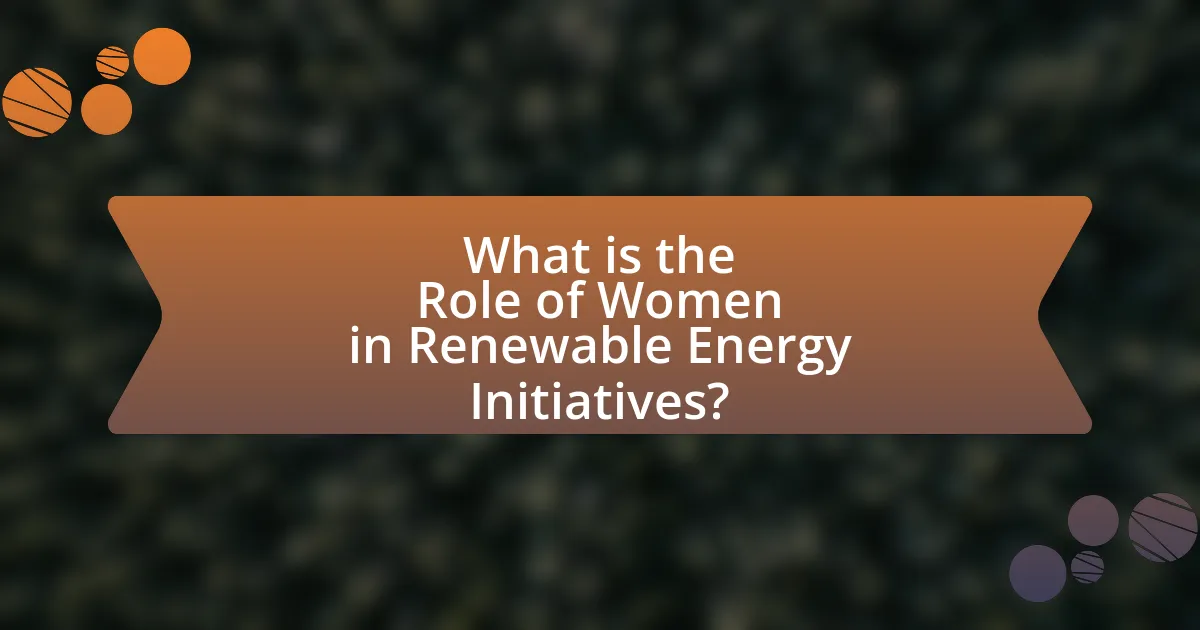The article examines the critical role of women in renewable energy initiatives globally, highlighting their contributions to innovation, community engagement, and sustainable practices. It presents case studies from various countries, including India, Bangladesh, and Kenya, showcasing how women’s involvement enhances project outcomes and energy access. The article also discusses the specific roles women play in renewable energy projects, the challenges they face, and strategies to improve their participation, emphasizing the importance of gender diversity in achieving sustainable energy goals. Additionally, it explores future prospects and emerging opportunities for women in the renewable energy sector.

What is the Role of Women in Renewable Energy Initiatives?
Women play a crucial role in renewable energy initiatives by driving innovation, enhancing community engagement, and promoting sustainable practices. Their involvement often leads to improved project outcomes, as evidenced by case studies showing that women-led initiatives in solar energy have increased access to clean energy in rural areas. For instance, in India, the Solar Mamas program trains women to become solar engineers, resulting in over 1,000 women gaining skills and creating sustainable energy solutions for their communities. This demonstrates that women’s participation not only empowers them but also contributes significantly to the advancement of renewable energy goals globally.
How have women contributed to renewable energy initiatives globally?
Women have significantly contributed to renewable energy initiatives globally by leading projects, advocating for sustainable practices, and driving policy changes. For instance, in countries like Bangladesh, women have been instrumental in the Solar Home Systems program, which has installed over four million solar home systems, improving energy access for rural communities. Additionally, women in Kenya have played a crucial role in the development of community-based wind energy projects, enhancing local energy resilience. Research from the International Renewable Energy Agency (IRENA) indicates that increasing women’s participation in the renewable energy sector can lead to more inclusive and effective energy solutions, highlighting their vital role in achieving global sustainability goals.
What specific roles do women play in renewable energy projects?
Women play critical roles in renewable energy projects, including leadership positions, technical roles, and community engagement. In leadership, women often serve as project managers or executives, driving strategic decisions and ensuring project success. In technical roles, they contribute as engineers, researchers, and technicians, applying their expertise to design and implement renewable energy solutions. Additionally, women engage with local communities to promote awareness and adoption of renewable technologies, often acting as educators and advocates. For instance, a study by the International Renewable Energy Agency (IRENA) found that increasing women’s participation in the renewable energy sector can enhance project outcomes and foster sustainable development.
How do women’s contributions differ across various regions?
Women’s contributions to renewable energy initiatives vary significantly across regions due to cultural, economic, and social factors. In Sub-Saharan Africa, women often play crucial roles in community-based renewable energy projects, such as solar energy cooperatives, where they are involved in both decision-making and implementation, reflecting a strong emphasis on grassroots participation. In contrast, in North America and Europe, women’s contributions tend to be more focused on leadership and technical roles within established companies and organizations, driven by higher access to education and professional opportunities. For instance, a report by the International Renewable Energy Agency (IRENA) highlights that women hold approximately 30% of leadership positions in renewable energy sectors in Europe, compared to around 10% in many African nations. This disparity illustrates how regional differences in gender equality and economic development influence women’s roles in renewable energy initiatives.
Why is the involvement of women in renewable energy important?
The involvement of women in renewable energy is important because it enhances innovation, improves project outcomes, and promotes gender equality in the energy sector. Research indicates that diverse teams, including women, are more effective in problem-solving and generating creative solutions, which is crucial for the rapidly evolving renewable energy landscape. For instance, a study by the International Renewable Energy Agency (IRENA) found that increasing women’s participation in the energy sector can lead to a 20-30% increase in project performance. Furthermore, women’s engagement in renewable energy initiatives helps address energy poverty, as women are often key decision-makers in household energy use, thereby ensuring that energy solutions are more inclusive and sustainable.
What impact does women’s participation have on project outcomes?
Women’s participation significantly enhances project outcomes in renewable energy initiatives. Studies indicate that projects with higher female involvement tend to achieve better sustainability and efficiency. For instance, a report by the International Renewable Energy Agency (IRENA) found that gender-inclusive teams are more likely to innovate and address diverse community needs, leading to improved project acceptance and success rates. Furthermore, research published in the journal “Energy Policy” highlights that women’s engagement in decision-making processes correlates with increased project effectiveness and community benefits, demonstrating the critical role women play in driving successful renewable energy initiatives.
How does gender diversity influence innovation in renewable energy?
Gender diversity significantly enhances innovation in renewable energy by fostering a broader range of perspectives and ideas. Research indicates that diverse teams are more likely to develop creative solutions and drive innovation, as they combine different experiences and viewpoints. For instance, a study by McKinsey & Company found that companies in the top quartile for gender diversity on executive teams were 21% more likely to experience above-average profitability, highlighting the economic benefits of diverse leadership. Furthermore, the International Renewable Energy Agency (IRENA) reported that increasing women’s participation in the renewable energy sector could lead to more effective problem-solving and innovation, as women often bring unique insights into energy needs and sustainability practices. Thus, gender diversity not only contributes to innovative approaches in renewable energy but also aligns with improved organizational performance and societal benefits.

What are some notable case studies of women in renewable energy?
Notable case studies of women in renewable energy include the work of Dr. Tania B. B. de Almeida in Brazil, who led a project that integrated solar energy into rural communities, significantly improving access to electricity for over 1,000 households. Another example is the Solar Sister initiative, founded by Katherine Lucey, which empowers women in Africa by training them to distribute solar products, thereby enhancing energy access and creating economic opportunities. Additionally, the Women in Renewable Energy (WiRE) network in Canada has successfully connected women professionals in the sector, fostering collaboration and innovation in renewable energy projects. These case studies illustrate the impactful roles women play in advancing renewable energy solutions globally.
Which countries have successful examples of women’s involvement in renewable energy?
Countries with successful examples of women’s involvement in renewable energy include Bangladesh, India, and Kenya. In Bangladesh, the Solar Home Systems project has empowered women by enabling them to become solar entrepreneurs, with over 50% of the solar microfinance clients being women. In India, initiatives like the Self-Employed Women’s Association (SEWA) have facilitated women’s participation in solar energy projects, leading to the installation of solar panels in rural areas. Kenya has seen women actively involved in community-based renewable energy projects, particularly in biogas and solar energy, contributing to both energy access and economic empowerment. These examples demonstrate the significant role women play in advancing renewable energy solutions globally.
What initiatives in India highlight women’s roles in solar energy?
Initiatives in India that highlight women’s roles in solar energy include the Solar Mamas program and the Self-Employed Women’s Association (SEWA). The Solar Mamas program, initiated by Barefoot College, trains women, particularly grandmothers, from rural areas to become solar engineers, enabling them to install and maintain solar systems in their communities. SEWA has also been instrumental in promoting solar energy among women by providing training and access to solar technologies, thereby empowering them economically and socially. These initiatives demonstrate the significant impact women have in advancing solar energy solutions in India, contributing to both energy access and gender equality.
How have women in Kenya transformed community energy access?
Women in Kenya have significantly transformed community energy access by leading initiatives that promote renewable energy solutions, particularly solar energy. Through organizations such as the Solar Sister program, women have become entrepreneurs, distributing solar products and providing energy solutions to rural households. This empowerment has resulted in increased access to clean energy for over 1.5 million people in Kenya, reducing reliance on kerosene and improving health and economic outcomes. Furthermore, women’s involvement in energy cooperatives has fostered community engagement and sustainable practices, demonstrating their critical role in advancing energy access and promoting environmental sustainability.
What challenges do women face in renewable energy initiatives?
Women face significant challenges in renewable energy initiatives, including gender bias, limited access to funding, and lack of representation in decision-making roles. Gender bias often results in women being overlooked for leadership positions and opportunities within the sector. Limited access to funding restricts women’s ability to start or scale renewable energy projects, as financial institutions frequently favor male-led initiatives. Additionally, women’s underrepresentation in decision-making roles leads to a lack of consideration for their perspectives and needs in energy policies and projects. According to the International Renewable Energy Agency (IRENA), women make up only 32% of the renewable energy workforce, highlighting the systemic barriers they encounter in this field.
What barriers hinder women’s participation in the renewable energy sector?
Barriers hindering women’s participation in the renewable energy sector include gender stereotypes, lack of access to education and training, limited networking opportunities, and insufficient financial resources. Gender stereotypes often lead to the perception that technical roles are male-dominated, discouraging women from pursuing careers in this field. According to a report by the International Renewable Energy Agency (IRENA), women represent only 32% of the renewable energy workforce, highlighting the impact of these stereotypes. Additionally, women frequently face challenges in accessing education and training programs tailored to renewable energy, which limits their skill development. Networking opportunities are often less accessible to women, further isolating them from industry advancements. Financial barriers also play a significant role, as women may have less access to funding and investment for renewable energy projects compared to their male counterparts.
How do cultural factors affect women’s roles in energy projects?
Cultural factors significantly influence women’s roles in energy projects by shaping their access to resources, decision-making power, and participation levels. In many societies, traditional gender norms restrict women’s involvement in technical fields, leading to underrepresentation in energy initiatives. For instance, a study by the International Renewable Energy Agency (IRENA) found that in regions where cultural beliefs prioritize male authority, women’s participation in energy projects can drop to as low as 10%. Additionally, cultural perceptions of women’s capabilities can hinder their access to training and funding, further limiting their roles. In contrast, cultures that promote gender equality often see higher female engagement in energy projects, as evidenced by successful initiatives in Scandinavian countries, where women hold significant leadership positions in renewable energy sectors.
How can we enhance women’s participation in renewable energy initiatives?
Enhancing women’s participation in renewable energy initiatives can be achieved through targeted education and training programs that empower women with the necessary skills. For instance, programs like the Solar Sister initiative have successfully trained women in Africa to become solar entrepreneurs, leading to increased access to renewable energy in their communities. Additionally, policies that promote gender equality in energy sectors, such as quotas for women’s representation in decision-making roles, can further facilitate their involvement. Research by the International Renewable Energy Agency (IRENA) indicates that increasing women’s participation in the energy sector can lead to more sustainable and inclusive energy solutions, highlighting the importance of integrating gender perspectives in energy planning and implementation.
What strategies can be implemented to support women in this field?
To support women in renewable energy initiatives, organizations can implement mentorship programs that connect women with experienced professionals in the field. Research indicates that mentorship significantly enhances career advancement and job satisfaction for women, as evidenced by a study published in the Journal of Business and Psychology, which found that mentees are more likely to receive promotions and salary increases. Additionally, providing access to training and education specifically tailored for women can help bridge the skills gap, as highlighted by the International Renewable Energy Agency, which reported that targeted training programs increase women’s participation in renewable energy sectors. Furthermore, creating inclusive workplace policies that promote work-life balance and address gender biases can foster a supportive environment, as shown in a report by McKinsey & Company, which emphasizes that diverse teams lead to better performance and innovation.
How can education and training programs empower women in renewable energy?
Education and training programs empower women in renewable energy by providing them with the necessary skills and knowledge to participate in this sector. These programs enhance women’s technical competencies, enabling them to take on roles in installation, maintenance, and management of renewable energy technologies. For instance, the International Renewable Energy Agency (IRENA) reported that increasing women’s participation in the renewable energy workforce can lead to a more diverse and innovative industry, which is crucial for achieving global energy goals. Furthermore, targeted initiatives, such as the Solar Sister program, have successfully trained women in Africa to become solar entrepreneurs, demonstrating that education and training can lead to economic independence and community development.
What role do policies play in promoting gender equality in energy initiatives?
Policies play a crucial role in promoting gender equality in energy initiatives by establishing frameworks that ensure equal access and participation for women in the energy sector. These policies can mandate gender-responsive planning, allocate resources for women’s empowerment, and promote women’s leadership in energy projects. For instance, the International Renewable Energy Agency (IRENA) reports that countries with gender-inclusive energy policies see higher rates of women’s participation in renewable energy jobs, which can lead to more sustainable and equitable energy systems. By integrating gender considerations into energy policies, governments can address systemic barriers and create an environment where women can contribute to and benefit from energy initiatives equally.
What best practices can be adopted for successful women’s involvement?
To ensure successful women’s involvement in renewable energy initiatives, organizations should implement targeted training programs that enhance skills and knowledge specific to the sector. Evidence shows that women who receive training in technical and leadership skills are more likely to participate actively and effectively in renewable energy projects. For instance, the International Renewable Energy Agency (IRENA) reported that gender-inclusive training programs can increase women’s participation rates by up to 30%. Additionally, creating supportive networks and mentorship opportunities fosters collaboration and empowerment among women in the field, further enhancing their contributions to renewable energy initiatives.
How can collaboration between organizations enhance women’s roles in renewable energy?
Collaboration between organizations can enhance women’s roles in renewable energy by creating networks that provide access to resources, training, and leadership opportunities. For instance, partnerships between non-profits, government agencies, and private companies can facilitate mentorship programs specifically designed for women, helping them gain the skills needed to excel in the renewable energy sector. Research from the International Renewable Energy Agency (IRENA) indicates that gender-inclusive policies and collaborative initiatives can lead to a 30% increase in women’s participation in the energy workforce. By pooling resources and expertise, organizations can also develop targeted programs that address the unique challenges women face in this field, thereby fostering a more inclusive environment that empowers women to take on leadership roles in renewable energy projects.
What lessons can be learned from successful case studies to replicate elsewhere?
Successful case studies in renewable energy initiatives demonstrate that empowering women as leaders and decision-makers significantly enhances project outcomes. For instance, the Barefoot College in India successfully trained women from rural areas to become solar engineers, resulting in increased energy access and community development. This model illustrates that investing in women’s education and skills not only fosters gender equality but also drives sustainable energy solutions. Furthermore, collaboration with local communities ensures that projects are culturally relevant and widely accepted, as seen in various initiatives across Africa and Latin America. These examples underscore the importance of integrating gender perspectives and community involvement in renewable energy projects to replicate success globally.
What are the future prospects for women in renewable energy initiatives?
The future prospects for women in renewable energy initiatives are promising, driven by increasing recognition of gender diversity’s benefits in the sector. Research indicates that companies with diverse leadership teams are 21% more likely to outperform their peers in profitability, highlighting the economic advantages of including women in renewable energy roles. Furthermore, initiatives such as the United Nations’ Sustainable Development Goals emphasize gender equality, encouraging women’s participation in sustainable energy projects. As of 2021, women represented only 32% of the renewable energy workforce, but this figure is expected to rise as educational programs and mentorship opportunities expand, fostering a more inclusive environment.
How can emerging technologies create new opportunities for women in this sector?
Emerging technologies can create new opportunities for women in the renewable energy sector by enabling access to education, enhancing job creation, and fostering innovation. For instance, advancements in digital platforms allow women to participate in online training programs, which can lead to skill development in renewable energy technologies. According to the International Renewable Energy Agency (IRENA), women represent only 32% of the renewable energy workforce, but targeted initiatives leveraging technology can significantly increase this percentage. Furthermore, technologies such as solar microgrids and energy storage systems empower women entrepreneurs to establish and manage energy businesses, thereby contributing to economic growth and community resilience.
What trends indicate the growing importance of women’s roles in renewable energy?
The growing importance of women’s roles in renewable energy is indicated by increasing participation rates, leadership positions, and targeted initiatives aimed at empowering women in the sector. For instance, the International Renewable Energy Agency (IRENA) reported that women’s employment in renewable energy sectors has risen significantly, with women now holding 32% of jobs in the renewable energy field, compared to 22% in traditional energy sectors. Additionally, initiatives like the Women in Renewable Energy (WiRE) network are specifically designed to support and promote women’s leadership and involvement in renewable energy projects globally. These trends highlight a shift towards inclusivity and recognition of women’s contributions to sustainable energy solutions.
